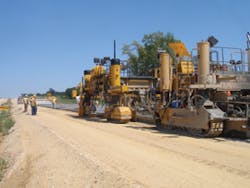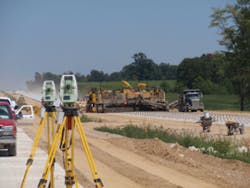Studies show that smoothness ranks at the top of what Americans want to see and experience when driving their highways. And several contractors are reporting that they produce smoother concrete pavements-and earn more smoothness bonuses-by using machine-control systems from Leica Geosystems.
Automated machine control saves time and money because it eliminates all of the detailed survey labor normally spent for a runway, staking of hubs, setting blue-tops, and the labor to set up stringlines. Typically, a concrete paver is controlled by two stringlines set at precise locations on each side of the lane being paved.
An excellent example is Fred Weber Inc., based in Maryland Heights, MO, a St. Louis suburb. “When we would pave with a stringline, we were just happy to get 100% of our pay,” says Nick Hilton, manager of concrete operations for Fred Weber. “Now, with the Leica PaveSmart 3D stringless system, we’re not happy unless we’re getting a bonus for smoothness.”
Weber earned 5% bonuses, the maximum allowed by the state of Missouri, over a significant share of paving sections on two Highway 364 projects near St. Charles, MO. On the majority of Highway 364 sections, Hilton said Weber consistently earned a minimum of 3% bonuses.
This year, Weber is building a new 10-mile section of Interstate 69 near Newberry, IN. It’s a four-lane divided highway for which the contractor is placing 11 inches of new concrete pavement. Early profilograph readings indicate that Weber earned an average of 3% bonuses on 25 sections of the northbound passing lane.
The pavement base consists of 6 inches of 1-inch-minus base stone topped by 3 inches of clean crushed stone. To place and trim the 3-inch layer, the contractor is using a Gomaco PS-2600, with a 7500 series rock spreader attachment, controlled by a Leica PaveSmart 3D (LMGS-S) machine-control system. The Gomaco PS-2600 works 30 feet wide, and Hilton attributes a share of his smoothness results to the stringless control system on the PS-2600.
Integrating seamlessly with any Gomaco paver or trimmer, the Leica system regulates the steering and grade of the trimmer with no need to retrofit complex hydraulics. The system guides the trimmer in relation to a digitized 3D model of the highway, running on the Leica computer onboard the paver.
The PS-2600 is equipped with two prisms, mounted above the machine, as targets for the Leica robotic total stations. When setting up the robotic total stations, a technician back-sights each of them
Leica’s PaveSmart 3D integrates
seamlessly with any Gomaco paver.
to three known control points. That fixes the location of the total stations relative to the digital model. The two total stations then follow the movement of the two prisms on the paver and communicate to the machine computer the trimmer’s precise location via radio link. The machine computer then computes the differences between the trimmer’s actual location and the digital terrain model. Knowing those differences, the Leica computer then instructs the onboard Gomaco G22 controller to regulate the machine’s steering and grade fully automatically.
For the mainline concrete paving stage, in this case using Weber’s Gomaco GHP-2800 paver, two of four robotic total stations are set out 400 to 500 feet ahead of the Gomaco, and two are set at 800 to 1,000 feet out. As the machine passes the two total stations in front of it, the crew switches control to the two furthest total stations and moves the near ones out further. That way the crew leapfrogs the total stations down the highway-and the Gomaco paver never stops-a capability unique to Leica’s technology.
For paving at I-69, Weber’s Gomaco GHP-2800 concrete paver works 30 feet wide. On one side of centerline of the pavement, Weber is paving 2 feet into the shoulder. When you add the 12-foot driving lane, that side is 14 feet wide. The 2-foot width assures that traffic will not run on the joint of the concrete to an asphalt shoulder. The other side of the centerline consists of a 12-foot driving lane plus a 4-foot shoulder.
Weber uses a Gomaco PS-2600 belt placer to place concrete ahead of the Gomaco GHP-2800 paver. On average during a paving shift, some 30 dump trucks are hauling concrete from a RexCon Model S batch plant to the project. “We average about 300 cubic yards per hour, hauling 9-yard loads,” says Hilton. “And depending on how long we run in the day, we’re shooting for 2,500 to 3,000 feet per day. We aim to finish up this project by November first.”
“We love it,” says Hilton of his Leica PaveSmart 3D (LMGS-S) stringless control system. “We like the mobility and ease of access to the project. You don’t have a stringline up in the way any more. Nobody can trip over the stringline or bump it to throw it off line. Plus, it frees up manpower to do something else. And our profilograph numbers have come way down since we’ve been running the Leica system.”
We asked Hilton how Weber crews are able to achieve such good smoothness numbers. “We trim with the Leica stringless system,” he says. “We’ll trim all the way out into the trackline. And that seems to help. Basically your paver track is running on a smooth ride. And then you take the human error out of it. There’s human error in setting stringline and eyeballing it, and we don’t have that anymore.
Matt Douglass, Weber’s Leica Manager for Paving Systems, adds that experience with the Leica machine control system helps. “We started out running pretty decently, but we have just gotten better and better as time goes along,” says Douglass.




